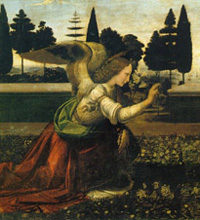
| Annunciation detail © Galleria degli Uffizi |
The Da Vinci Glow
(Dr. Tony Phillips, Science@NASA) - When you think of Leonardo Da Vinci, you probably think of the Mona Lisa or 16th-century submarines or, maybe, a certain suspenseful novel. That's old school. From now on, think of the Moon.
Little-known to most, one of Leonardo's finest works is not a painting or an invention, but rather something from astronomy: He solved the ancient riddle of Earthshine.
You can see Earthshine whenever there's a crescent Moon on the horizon at sunset. Thursday, Oct. 6, is a good night: sky map. Look between the horns of the crescent for a ghostly image of the full Moon. That's Earthshine.
For thousands of years, humans marveled at the beauty of this "ashen glow," or "the old Moon in the new Moon's arms." But what was it? No one knew until the 16th century when Leonardo figured it out.
In 2005, post-Apollo, the answer must seem obvious. When the sun sets on the Moon, it gets dark--but not completely dark. There's still a source of light in the sky: Earth. Our own planet lights up the lunar night 50 times brighter than a full Moon, producing the ashen glow.
Visualizing this in the 1500s required a wild kind of imagination. No one had ever been to the Moon and looked "up" at Earth. Most people didn't even know that Earth orbited the sun. (Copernicus' sun-centered theory of the solar system wasn't published until 1543, twenty-four years after Leonardo died.)
Wild imagination was one thing Leonardo had in abundance. His notebooks are filled with sketches of flying machines, army tanks, scuba gear and other fantastic devices centuries ahead of their time. He even designed a robot: an armored knight that could sit up, wave its arms, and move its head while opening and closing an anatomically correct jaw.
To Leonardo, Earthshine was an appealing riddle. As an artist, he was keenly interested in light and shadow. As a mathematician and engineer, he was fond of geometry. All that remained was a trip to the Moon. It was a mental journey:
In Leonardo's Codex Leicester, circa 1510, there is a page entitled "Of the Moon: No Solid Body is Lighter than Air." He states his belief that the Moon has an atmosphere and oceans. The Moon was a fine reflector of light, Leonardo believed, because it was covered with so much water. As for the "ghostly glow," he explained, that was due to sunlight bouncing off Earth's oceans and, in turn, hitting the Moon.
He was wrong about two things: First, the Moon has no oceans. When Apollo 11 astronauts landed at the Sea of Tranquility, they stepped out onto rock. Lunar "seas" are made of ancient hardened lava, not water.
Second, Earth's oceans are not the primary source of Earthshine. Clouds are. Earth shines because it reflects sunlight, and clouds do most of the reflecting. When Apollo astronauts looked at Earth, the oceans were dark and the clouds were bright.
But these are quibbles. Leonardo understood the basics well enough.
In the decades ahead, humans are going to travel in person where Leonardo's imagination went 500 years ago. NASA plans to send astronauts back to the Moon no later than the year 2018. Unlike Apollo astronauts, who stayed for a few days at most, these new explorers will remain on the Moon for weeks and months. In the process, they'll experience something Apollo astronauts never did: nightfall. A lunar "day" is 29.5 Earth-days long: about 15 Earth-days of light, followed by 15 Earth-days of darkness. Apollo astronauts always landed in daylight and took off again before sunset. Because of the bright sun, they never saw the soft glow of Earthshine at their feet. But the next generation of astronauts will.
And just maybe, on a late-night stroll behind the outpost, guided by the soft light of Earth, one of them will bend over and scratch something in the moondust:
"Leonardo was here."
